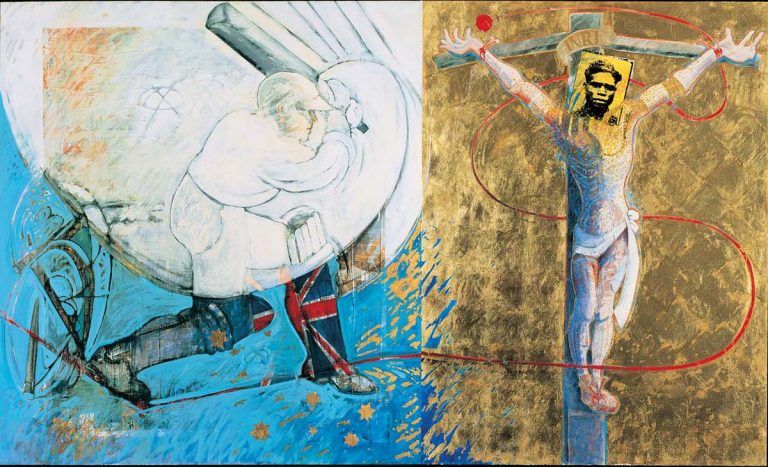We acknowledge the Traditional Owners of the land on which the Queensland Art Gallery | Gallery of Modern Art stands and recognise the creative contribution First Australians make to the art and culture of this country.

Ron Hurley / Gurang Gurang/Mununjali people / Australia 1946–2002 / Bradman bowled Gilbert 1989 / Oil on canvas / 182.4 x 304.5cm / Purchased 1990 / Collection: Queensland Art Gallery | Gallery of Modern Art / © Ron Hurley. Licensed by Copyright Agency, 2020.
Ron HurleyBradman bowled Gilbert 1989
Not Currently on Display
Ron Hurley grew up hearing stories about the Queensland Aboriginal fast pace bowler Eddie Gilbert, who was famous for twice getting out the legendary batsman Donald Bradman. Gilbert was born in 1908, the same year as Bradman, at Woodford, near Brisbane and raised as a ward of the state at Barambah Aboriginal Settlement (later Cherbourg). During his short career from 1931 to 1936, Gilbert represented Queensland in 19 Sheffield Shield matches and played against the West Indies, South Africa and England. Despite playing first class cricket, Gilbert had to live in a tent in the backyard of the secretary of the Queensland Cricket Association, returning to Barambah between matches. Widely regarded as Australia’s fastest bowler, Gilbert was never selected for test cricket.
Bradman bowled Gilbert is based on a memorable day in November 1931 at the Brisbane Cricket Ground (the “Gabba”) when Gilbert bowled five balls to Bradman at devastating speed. On the fifth ball, wicket keeper Les Waterman caught Bradman for a duck off Gilbert’s bowling.
Gilbert’s victory was marred by allegations of throwing made by the New South Wales team manager after the match. Although slow motion film of his bowling subsequently exonerated Gilbert, a newspaper report in 1933 described the cricketer as ‘disheartened’. This controversy, coupled with a shoulder injury, prevented him from being chosen to tour interstate for the next two years. Despite other successes in the succeeding years, Gilbert never regained his earlier sensational form. This work contrasts the separate fates of the two talented cricketers from very different cultural backgrounds.
Ron Hurley was born in 1946 in the Brisbane suburb of Mt Gravatt. On his mother’s side he belonged to the Goreng Goreng people (whose ancestral lands lie from Gladstone to Bundaberg), and on his father’s side he was descended from the Mullunjali (Mundanjali) people from Beaudesert. He completed his art education at the Queensland College of Art from 1973 to 1975 and was the first Aboriginal person to graduate from the college.
Throughout his career, Hurley worked as a commercial artist, sign writer and screen printer, and later as a teacher, curator and arts manager. He was a role model to many young Indigenous artists, initiating and facilitating workshops to communities in Far North Queensland. A passionate advocate and campaigner for Aboriginal and Torres Strait Islander art and culture, Hurley engaged with various boards and committees at state and national levels, giving advice on Indigenous and arts-related issues. He was a Trustee of the Queensland Art Gallery from 1996–97.
Commenting on his own artistic practice, he said:
At long last the world is responding in a more positive manner [to Aboriginal art], and traditional art is being looked at in its rightful context. It is the very fibre of our country’s imagery. The urban Aboriginal situation is the one which captures my imagination, for it is here that one experiences ‘limboism’, being neither Black or White… A world of such extreme contrast is the one to which I have learned to respond, survive, and attempt to create in.1
Endnotes:
Ron Hurley, on the artist’s own website, viewed September 2017.